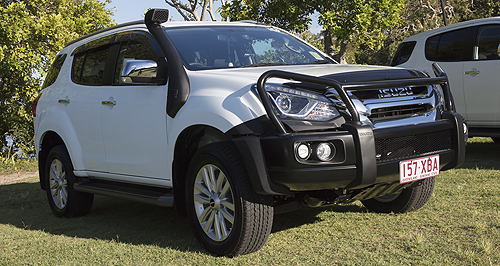News - IsuzuIsuzu keeps faith with bigger engine, for nowBig banger: Isuzu chose to update its larger, older 3.0-litre four-cylinder diesel rather than offer the newer, smaller 1.9-litre unit (left), despite similar outputs. Marketing beats engineering for new 3.0L Isuzu engine, but it may not be enough1 May 2017 By TIM ROBSON ISUZU Ute Australia (IUA) has listened to its heartland and chosen to upgrade a fan favourite engine, rather than risk a sales backlash by downsizing to a newer, more efficient but smaller unit. The company has now updated its 3.0-litre four-cylinder turbo-diesel unit in both its D-Max ute and MU-X SUV model lines with technology to meet Euro 5 emissions standards, despite introducing a new 1.9-litre diesel last year in the Thai-market model. The 1.9-litre, four-cylinder RZ4E-TC DDI Blue Power engine makes 110kW and 350Nm (down 20kW/80Nm on the updated 3.0 litre), and is up to 60kg lighter than the 3.0-litre engine. Isuzu’s smaller capacity Euro 5 emissions-compliant motor is claimed to be 19 per cent more fuel efficient, as well as producing just 161g of CO2 per kilometre. IUA director of sales and marketing Yugo Kiyofuji told journalists at the launch of the updated MU-X in Queensland that the company had considered using the smaller engine, but had ultimately decided that it may have been a backwards step. “We believe that the displacement figure is a selling point,” Mr Kiyofuji said. “Based on internal research, many still believe that bigger displacement means a better and stronger engine, even though engine displacements are downsizing across the industry. “But still, the consumer expectation is that we keep the 3.0-litre and not use our latest 1.9-litre engine, and that’s one of the reasons we asked Isuzu to make our 3.0-litre engine compliant with Euro 5 instead. The customers are pretty happy with it. “If we bring 1.9-litre engine to Australia, I get killed or stabbed by dealers,” jokingly added IUA managing director and CEO Yasu Takeuchi. However, Isuzu Motors president and senior executive officer, Yoichi Masuda, suggested to GoAuto that emissions pressures were mounting on the small company. “All countries all around the world are suffering from high emissions regulations,” Mr Masuda, who is based in Bangkok, said. “Maybe it will be the same all over the world. In this respect, we have to apply future resources for developing engineering solutions. “We are concentrating on improving the existing technology to suit this demand.”“It depends on which emissions standard is going to be introduced for Australia,” added Mr Kiyofuji. “Isuzu doesn’t have the answer yet on that. We are keeping an eye on what they decide. At the earliest, nothing will be decided (before) 2020.” The updated 4JJ1-TC 3.0-litre turbocharged diesel four-cylinder engine received a new piston design, fuel injectors and variable geometry turbocharger, as well as a larger EGR cooler and a new diesel particulate filter needed to meet Euro 5 standards. IUA officials confirmed that the company had investigated the potential of fitting a urea-based AdBlue emissions system to the 4JJ1-TC, but had dismissed it on the basis that AdBlue’s availability is not wide spread. AdBlue needs to be topped up approximately every 10,000km, where the DPF burns the carbon it collects every 500km. Power output for the engine remains at 130kW, while torque jumps 50Nm to 430Nm. Up to 380Nm of that torque is delivered over a wider range of 1700–3500rpm, according to Isuzu. Claimed fuel consumption remains the same at 7.9 litres per 100km on the combined fuel economy cycle, and it emits between 208 and 214g of CO2 per kilometre depending on spec.  Read more1st of May 2017  Driven: Isuzu updates MU-X for 2017 againEuro 5 engine for Isuzu MU-X joined by updated interior and trim for 201711th of February 2017  Isuzu pondering Wildtrak rival as D-Max flagshipD-Max Z-Prestige model sold overseas could become Isuzu Ute flagship in Australia |
Click to shareIsuzu articlesMotor industry news |
















Facebook Twitter Instagram